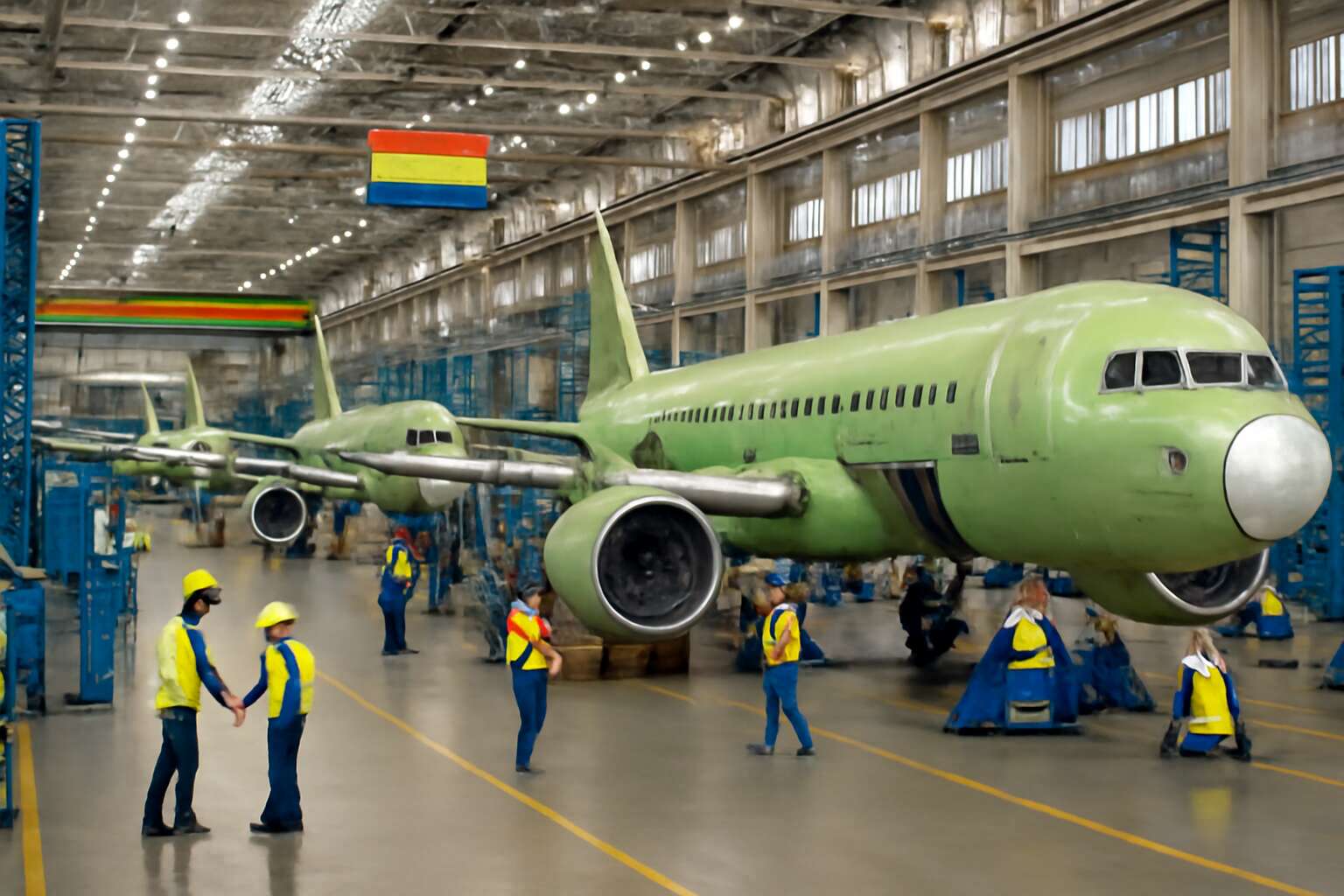Overview of the Indian Aerospace Industry
Evolution and Growth – Historical development and recent advancements
India’s aerospace industry, once a fledgling sector rooted in modest military and civilian aviation pursuits, has metamorphosed into a formidable hub of technological innovation and manufacturing prowess. The journey from rudimentary assembly to the creation of sophisticated aircraft is nothing short of remarkable, reflecting a nation’s relentless pursuit of self-reliance and excellence. Historically, the sector gained momentum in the post-independence era, with government initiatives fostering indigenous capabilities and laying the groundwork for future advancements.
Recent advancements have cemented India’s position as a significant player in the global aerospace arena. Today, where aeroplanes are made in India, cutting-edge facilities such as Hindustan Aeronautics Limited (HAL) and private sector giants like Tata and Airbus have established state-of-the-art manufacturing complexes. These establishments are not merely assembling aircraft; they are pioneering innovations in aerostructure design, engine technology, and avionics. The evolution of the Indian aerospace industry embodies a blend of strategic vision and technological resilience, making the question of where aeroplanes are made in India increasingly relevant to global aerospace supply chains.
Key Players in India – Major aerospace and defense companies
India’s aerospace industry is no longer just a dusty corner of military and civilian aviation; it’s a buzzing hub of innovation and manufacturing prowess. When it comes to where aeroplanes are made in India, the landscape is rich with powerhouse companies that have put the country on the global aerospace map. These key players blend cutting-edge technology with a relentless drive for excellence, transforming India from a mere assembly locale into a full-fledged manufacturing powerhouse.
Leading the charge is Hindustan Aeronautics Limited (HAL), the stalwart of Indian aerospace manufacturing. With a heritage spanning over six decades, HAL produces everything from fighter jets to helicopters, and their sprawling facilities across Bangalore, Nashik, and Koraput are the backbone of India’s aircraft manufacturing capabilities. Besides HAL, private sector giants like Tata Advanced Systems and Airbus India have established state-of-the-art manufacturing complexes, further elevating India’s position in the global aerospace industry.
In fact, the question of where aeroplanes are made in India becomes even more intriguing when you consider the collaborative projects and joint ventures that have sprouted over the years. These partnerships often involve:
- Design and manufacturing of aircraft components
- Assembly of commercial aircraft
- Development of indigenous avionics systems
Such synergy not only bolsters India’s aerospace capabilities but also ensures the industry remains resilient and future-ready. From the bustling assembly lines of HAL to the high-tech facilities of Airbus and Tata, it’s clear that India’s aerospace manufacturing landscape is as diverse as it is dynamic.
India’s Aerospace Manufacturing Capacity – Current production capabilities and future potential
The Indian aerospace industry has been quietly transforming from a modest operation into a formidable manufacturing hub. Today, India’s aerospace manufacturing capacity is not just about assembling aircraft; it’s about creating a self-reliant ecosystem that can rival global giants. With current production capabilities focused on military aircraft, helicopters, and increasingly, commercial planes, the industry’s future is bright—and bustling!
At present, India’s aircraft manufacturing facilities are centered around key regions, notably Bangalore, Nashik, and Koraput. These hubs are equipped with state-of-the-art technology, capable of producing a range of aircraft components and even complete aircraft assembly. In fact, India’s aerospace manufacturing capacity is expected to expand significantly in the coming years, driven by government initiatives like the Make in India campaign and strategic collaborations with global aerospace giants.
What makes this industry particularly exciting is its potential for high-volume production. The Indian government has set ambitious targets to develop indigenous aircraft, including the Tejas fighter jet and the upcoming civil aircraft projects. This means that the question of where aeroplanes are made in India isn’t just about assembly lines—it’s about building a future where India stands tall as a global aerospace manufacturing powerhouse.
Major Aircraft Manufacturing Facilities in India
Hindustan Aeronautics Limited (HAL) – Locations, products, and significance
In the vast tapestry of Indian aviation, the heart of airplane manufacturing beats strongly at Hindustan Aeronautics Limited (HAL). This majestic organization is not merely a manufacturer; it is a symbol of India’s indomitable spirit in aerospace innovation. When exploring where aeroplanes are made in India, HAL’s sprawling facilities stand out as beacons of engineering prowess and national pride.
With multiple locations across the country, HAL’s primary manufacturing hub is nestled in Bangalore, Karnataka, where the skies seem to whisper tales of technological marvels. The facility in Nasik, Maharashtra, complements this with its advanced assembly lines, contributing to both military and civilian aircraft. These factories are not just production units; they are sanctuaries of cutting-edge aerospace technology, producing everything from fighter jets to transport aircraft, fueling India’s defense and commercial ambitions.
Among the key manufacturing facilities, the Bangalore complex alone is responsible for assembling iconic aircraft like the Tejas fighter jet and the Dornier aircraft series, integral to India’s defense strategy. The Nasik plant, on the other hand, specializes in the production of the Sukhoi Su-30MKI and other combat aircraft, making HAL a cornerstone of India’s aerospace industry. Such extensive infrastructure underscores the significance of these facilities in shaping where aeroplanes are made in India, transforming the country into a formidable player on the global aerospace stage.
Tata Advanced Systems – Collaborations and manufacturing projects
Among the key players shaping the landscape of Indian aerospace manufacturing, Tata Advanced Systems stands out as a beacon of innovation and strategic collaboration. This enterprise is not merely a manufacturer; it is a catalyst driving India’s ascent into the global aerospace arena. When exploring where aeroplanes are made in India, Tata’s advanced facilities and partnerships reveal a nuanced tapestry of technological prowess and national ambition.
With a focus on cutting-edge aerospace projects, Tata Advanced Systems has partnered with international aerospace giants to enhance India’s manufacturing capabilities. Their collaborations have resulted in the production of critical aircraft components and complete systems that meet global standards. This synergy exemplifies how India’s aerospace manufacturing capacity is evolving at an unprecedented pace.
Moreover, Tata’s manufacturing projects extend beyond traditional boundaries, integrating modern design principles and manufacturing techniques. The company’s facility in Hyderabad, for instance, is equipped with state-of-the-art technology that supports the assembly of complex aerostructures. Such advancements prompt the question—where aeroplanes are made in India? The answer lies in a confluence of innovation, strategic alliances, and relentless pursuit of excellence.
Private Sector Contributions – Role of private companies in aircraft production
Private sector contributions have become a vital force in shaping India’s aerospace landscape, especially when it comes to where aeroplanes are made in India. Unlike traditional government-led initiatives, forward-thinking private companies are now pioneering innovative manufacturing techniques and expanding capabilities at an unprecedented pace.
These enterprises not only assemble aircraft but also develop critical components, fueling India’s ambitions to become a global aerospace hub. For instance, companies like Larsen & Toubro and Mahindra Aerospace have invested heavily in establishing state-of-the-art facilities across the country. Their efforts include manufacturing regional jets, light aircraft, and aircraft parts that meet international standards.
In the quest to answer where aeroplanes are made in India, one cannot overlook the strategic importance of these private manufacturing hubs. They are often located in industrial corridors such as Bengaluru, Hyderabad, and Pune—regions rich in technological expertise and skilled labor. This growing ecosystem exemplifies India’s expanding footprint in the global aerospace industry, driven by private innovation and relentless pursuit of excellence.
Hindustan Aeronautics Limited (HAL) and Its Production Units
Bangalore – Major assembly and manufacturing plant
Hindustan Aeronautics Limited (HAL) stands as a pillar of India’s aerospace industry, with its sprawling production units primarily located in Bangalore. This city has become synonymous with aeronautical innovation, hosting HAL’s major assembly and manufacturing plant. It’s here that the journey of where aeroplanes are made in India reaches a pivotal point, transforming raw materials into sophisticated aircraft that serve both military and civilian needs.
The Bangalore facility is equipped with state-of-the-art technology that ensures the production of some of the most advanced fighter jets and trainers in the country. HAL’s plant in Bangalore doesn’t just assemble aircraft; it also plays a key role in designing, testing, and integrating cutting-edge aeronautical systems. This integrated approach is what keeps India competitive in the global aerospace arena, making it clear why HAL remains a cornerstone of where aeroplanes are made in India.
Kanpur – Aerospace engineering facility
Nestled in the heart of India’s aerospace landscape, the Kanpur aerospace engineering facility of Hindustan Aeronautics Limited (HAL) stands as a testament to the nation’s relentless pursuit of innovation. Known for its intricate craftsmanship and engineering prowess, this plant is a vital cog in the machinery of India’s aircraft manufacturing sector. It’s here that the magic of transforming cutting-edge designs into tangible aircraft unfolds, contributing significantly to where aeroplanes are made in India.
At the Kanpur facility, state-of-the-art technology merges seamlessly with traditional expertise, enabling the production of advanced military and civilian aircraft. The plant specializes in manufacturing aeronautical components that are integral to India’s defense capabilities and commercial aviation growth. Its strategic role ensures that India’s presence in the global aerospace arena continues to expand, making it a cornerstone of where aeroplanes are made in India.
Nasik – Component manufacturing hub
Hindustan Aeronautics Limited (HAL) is a cornerstone of India’s aerospace sector. Its expansive network of production units spans across the country, with the Nasik facility standing out as a key component manufacturing hub. Located in Maharashtra, this plant plays a vital role in producing critical aeronautical components that fuel India’s growing aviation industry.
At the Nasik unit, precision engineering meets advanced manufacturing technology. The facility specializes in crafting components for military jets, helicopters, and commercial aircraft, ensuring India’s self-reliance in aerospace manufacturing. The plant’s strategic importance is evident in its ability to deliver high-quality parts that meet international standards.
In fact, the Nasik facility exemplifies where aeroplanes are made in India—by creating the essential parts that form the backbone of the nation’s aircraft. The focus on innovation and quality makes this plant a vital player in India’s aerospace future.
Koraput – Specialized production and research units
Deep within the shadows of India’s vast aerospace landscape, the Koraput unit of Hindustan Aeronautics Limited (HAL) emerges as a crucible of innovation and clandestine craftsmanship. Nestled in the heart of Odisha, this specialized production and research facility is not merely a site of manufacturing but a sanctuary where the future of Indian aviation is forged in secrecy and precision. It’s here that the unseen gears turn—where aeroplanes are made in India not just in the visible assembly lines, but in the intricate, hidden processes that underpin every aircraft’s soul.
The Koraput unit is renowned for its mastery over complex aeronautical components, including advanced aerostructures and vital avionics parts. Its existence is vital to the sustenance of India’s defense capabilities and civil aviation ambitions. The facility operates with an almost arcane focus, ensuring that each piece produced adheres to the highest standards of quality and durability—standards that echo the silent strength of a midnight fortress.
Other Notable Manufacturing Sites and Partnerships
Tata Advanced Systems – Manufacturing collaborations for aircraft components
Beyond the well-known giants like HAL and Tata, India’s aerospace landscape boasts a constellation of specialized manufacturing sites and strategic partnerships. Tata Advanced Systems, for instance, has carved out a niche in aircraft component manufacturing through collaborations with global aerospace leaders. These partnerships enable India to produce high-precision parts that meet international standards, reinforcing the country’s position on the global aviation map.
One notable example is their work on aerostructures and avionics systems, which are integral to modern aircraft. The focus on quality and innovation at these sites underlines where aeroplanes are made in India, showcasing a blend of indigenous expertise and international cooperation. Such collaborations not only bolster India’s manufacturing capabilities but also promise to elevate the country’s aerospace industry to new heights, making it a hub for both assembly and cutting-edge component production.
Private Manufacturer Facilities – Examples and locations of private sector aircraft assembly plants
India’s aerospace manufacturing landscape is rapidly evolving, with private sector players stepping into the spotlight alongside stalwarts like HAL and Tata. These private manufacturers have established impressive facilities that play a crucial role in where aeroplanes are made in India. For instance, Bangalore houses a state-of-the-art aircraft assembly plant operated by a leading private aerospace firm. This facility specializes in integrating advanced avionics and fuselage sections, showcasing India’s burgeoning capacity for aircraft assembly.
Meanwhile, Kanpur’s aerospace engineering facilities are known for their cutting-edge work on aerostructures, often acting as the backbone for domestic and international aircraft projects. Nasik, often called the “component capital,” is bustling with private companies producing vital aircraft parts that meet global standards. Additionally, Koraput hosts specialized production and research units—think of it as India’s secret weapon in aerospace innovation! These sites collectively illustrate a vibrant private sector contributing significantly to India’s reputation as an aerospace manufacturing hub.
Here’s a quick overview of key private sector facilities involved in the manufacturing of aircraft in India:
- Bangalore – Major aircraft assembly and integration plant
- Kanpur – Aerospace engineering and fuselage manufacturing
- Nasik – Component manufacturing hub
- Koraput – Research and specialized production units
Each location underscores the diverse capabilities of India’s private aerospace industry, reinforcing the question of where aeroplanes are made in India isn’t just about assembly lines but a complex, multi-location symphony of innovation and precision craftsmanship.
Public-Private Partnerships – Joint ventures promoting aircraft manufacturing in India
While India’s aerospace landscape continues to captivate the world, several lesser-known manufacturing sites and strategic collaborations play pivotal roles in shaping its aviation future. Beyond the prominent facilities, other notable manufacturing hubs and public-private partnerships are quietly revolutionizing the industry. These collaborative ventures often involve joint ventures that pool resources, expertise, and innovation, turning India into a formidable player on the global aerospace stage.
For instance, the partnership between Tata Advanced Systems and global aerospace giants has led to the establishment of specialized production units focusing on aircraft components. These collaborations not only accelerate the manufacturing process but also embed cutting-edge technology into India’s aviation ecosystem. Such alliances often involve complex supply chains, ensuring that every part of the aircraft meets rigorous international standards.
Furthermore, there are several government-backed initiatives aimed at boosting indigenous aircraft manufacturing. These projects often involve a network of private and public sector facilities, each contributing uniquely to the puzzle of where aeroplanes are made in India. The synergy between these entities ensures that India’s aerospace manufacturing capacity continues to expand, with new sites emerging as key players in the evolving landscape.
Future of Aeroplane Manufacturing in India
Government Initiatives – Make in India and other policies supporting aerospace manufacturing
The future of aeroplane manufacturing in India is shimmering with promise, driven by strategic government initiatives that aim to elevate the country’s aerospace industry onto the global stage. Central to this vision is the Make in India campaign, which champions indigenous production and fosters a robust ecosystem for aerospace innovation. This initiative, complemented by progressive policies on defense and civil aviation, has created an environment ripe for growth and technological advancement.
With a focus on attracting private sector participation, the government has launched several public-private partnerships that catalyze the development of aircraft manufacturing facilities across the nation. These collaborations not only bolster India’s capacity but also encourage cutting-edge research and development. As a result, India is gradually transforming into a hub of aeroplane assembly and component manufacturing — a testament to its rising stature in the global aerospace arena.
- Enhanced infrastructure and incentives for aerospace startups
- Streamlined regulations to facilitate quicker project approvals
- Strategic alliances with international aerospace giants
Across India, cities like Bangalore, Kanpur, and Nasik are emerging as pivotal centers where aeroplanes are made in India. These regions are witnessing a surge in manufacturing capabilities, with dedicated facilities designed for assembly, engineering, and research. The trajectory is clear: India is not just a market for aircraft but a burgeoning manufacturing powerhouse poised to redefine where aeroplanes are made in India.
Upcoming Projects and Facilities – Planned expansions and new manufacturing units
As India’s aerospace ambitions soar like a phoenix emerging from the shadows, the future of aeroplane manufacturing in India beckons with a promise both tantalizing and profound. Upcoming projects and new manufacturing facilities are the silent heralds of a revolution brewing beneath the skies. Strategic expansions are underway, with several planned facilities set to transform India into a global hub for aircraft assembly and component manufacturing.
In the heart of this renaissance, cities like Bangalore, Nasik, and Kanpur are poised to become epicenters of innovation and craftsmanship. They will host cutting-edge manufacturing units designed to produce everything from fighter jets to commercial aircraft. The government’s focus on fostering private sector participation has opened a floodgate of opportunities, leading to the establishment of new plants and collaborations that promise to redefine where aeroplanes are made in India.
- New aerospace parks are being conceived in strategic locations, equipped with state-of-the-art infrastructure to support large-scale aircraft assembly.
- Private companies are forging partnerships with global giants, creating a web of manufacturing hubs across India that operate in the shadows of skyscrapers and sprawling industrial complexes.
As these ventures materialize, India’s skyline will soon be dotted with the outlines of future-ready aeroplane manufacturing units—each a testament to the nation’s relentless pursuit of aerospace excellence. The horizon is dark and promising, whispering of a time when India will no longer merely assemble aircraft but craft them with a mastery born of innovation and ambition.
Technological Innovations – Indigenous technology development for aircraft production
The future of aeroplane manufacturing in India is shrouded in a cloak of technological innovation and indigenous prowess. As the nation accelerates towards becoming a global aerospace powerhouse, groundbreaking developments in aircraft technology are paving the way for a new era of self-reliance. The emphasis on developing indigenous technology for aircraft production signifies not just progress but a dramatic shift in India’s aerospace narrative.
Efforts are underway to embed cutting-edge research and development into every facet of aircraft manufacturing. From advanced composite materials to next-generation avionics, India’s aerospace sector is forging a path that blends tradition with futuristic innovation. The government’s push for indigenous technology development ensures that the country is not merely a manufacturing hub but also a cradle of aerospace ingenuity.
Strategic collaborations are fueling this revolution, with private companies and global aerospace giants working hand-in-glove. These partnerships are creating a web of manufacturing hubs across India, where the craft of aeroplane building is elevated to an art form. In cities like Bangalore, Nasik, and Kanpur, new aerospace parks and dedicated research units are emerging, each a testament to India’s relentless pursuit of mastery in aircraft production.
- Developing indigenous engines and propulsion systems.
- Innovating in lightweight, durable materials for aircraft construction.
- Enhancing avionics and onboard systems through local R&D efforts.
As India’s aeroplane manufacturing capability expands, the nation is no longer just assembling aircraft; it is becoming a crucible of innovation. The dark skies above are now dotted with the promise of a future where India crafts its own wings—each one a symbol of resilience, ambition, and the relentless pursuit of aerospace excellence.




0 Comments